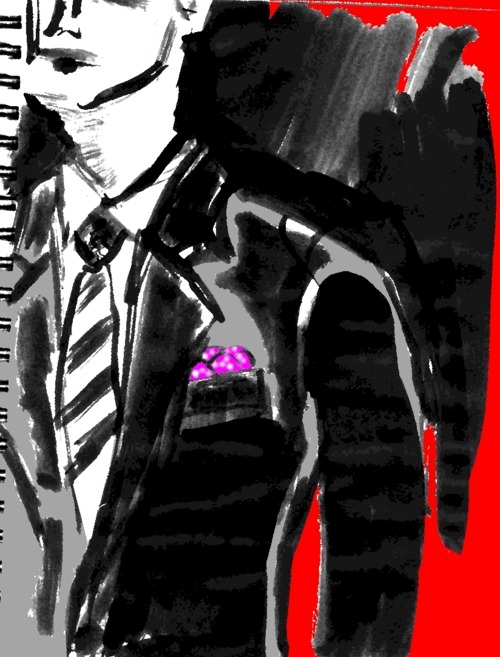Matters of the heart: breast pockets and the things we put in them

As a recent San Francisco Chronicle article declared: pocket squares, handkerchiefs, puffs, what have you, are returning to the menswear lexicon thanks to TV shows like Mad Men.
In Vancouver, a city which takes going casual seriously, the spray of fabric has become an acceptable replacement for a tie. It is dressy but not too dressy.
But what of the pocket that holds it: the breast pocket?
Imagine if the breast pocket were not there. What would be lost? Angled correctly a breast pocket, distinguished by the tab of fabric known as a welt, has the desirable effect of visually lifting and broadening the chest. Sometimes careless suit makers will make a breast pocket dead, flat horizontal, in which case, it would only visually fatten the wearer’s torso by making it look boxy.
But a great breast pocket rises slightly towards the shoulder. Not too acutely. If done right it can enliven the dead zone between the lapels and the shoulder and through the introduction of a slight diagonal sharpen the look of the wearer.
It is also the psychic hot spot of the suit for it lies over the heart. When you think of it, the suit jacket has two pockets in that special location. There is the one everyone sees. There is another that hides in the lining.
The inside pocket is an intimate holding place akin to a purse for women. Passports, bill folds, the notes for a speech. Famously, people may still keep a bible in the inside breast. And the cliche goes it may be able to save more than your soul. Both in the memoirs and correspondence of Union and Confederate soldiers in the Civil War, there are numerous accounts of how bibles stopped bullets from entering the heart.
Of course, pocket squares, pocket puffs or handkerchiefs do not have the same anti-ballistic properties but they too provide insight into a man’s character. When a man makes a consistent habit of ironing a square to have four peaks poking out of the breast pocket, it may signal a fastidious nature.
I think pocket squares are best when they reflect the wearer's mood the way a face does. It should change depending on the circumstance rather than be frozen in the perky smile of rigidity that is the peaked hankie.
For example, if you have a business meeting in the morning, make the kerchief a rigid square but by happy hour there’s nothing wrong with scrunching it up into a little rosette.
Now, back to matters of the heart. Wearing one is best when it is a gift from a lover. This practice has its origins in chivalry. Originally, kerchiefs were considered underwear. People weren’t supposed to see them. But in the Middle Ages romantic love became a viable idea. A lover’s handkerchief could find a place of honour on the armour of a knight. He would tie it underneath the plume of his helmet. The term “wearing your heart on your sleeve,” which is derived from Shakespeare’s Othello, refers to the practice of maidens giving their sleeves to their knight. And they in turn would tie them around their gauntlets.
If the modern man has yet to receive such tokens of affection, he might echo the tradition by wearing the favourite colour of a loved one.
For the rookie pocket square wearer, I recommend never matching the tie with the square. Try loosely folding it and plunging it into the breast pocket and pulling it out just a bit. Avoid fiddling. Menswear writer Russell Smith, author of Men’s Style, says do place the hankie with your eyes closed. I concur. I like my pocket squares heedless, unmediated, unguarded and without guile.
Sometimes, I don’t use cloth pocket squares. Paper do wonders in a pinch. On TV it looks just like a linen one.
The finest paper square I ever wore came from one pf my 7-year-old sons (yes, twins). He was angry at me. I had to go out for a fashion event. He had hopes we would spend the evening together playing board games. I suggested he make me a paper pocket hankie for me.
He squiggled and coloured an elaborate pattern with a richness equal to a Hermes or a Salvatore Ferragamo printed silk.
I told my son I would wear it all night and, if anyone asked, I would tell him or her who made it.
“Really?” he said.
I promised, “Cross my heart.”
Comments
Post a Comment